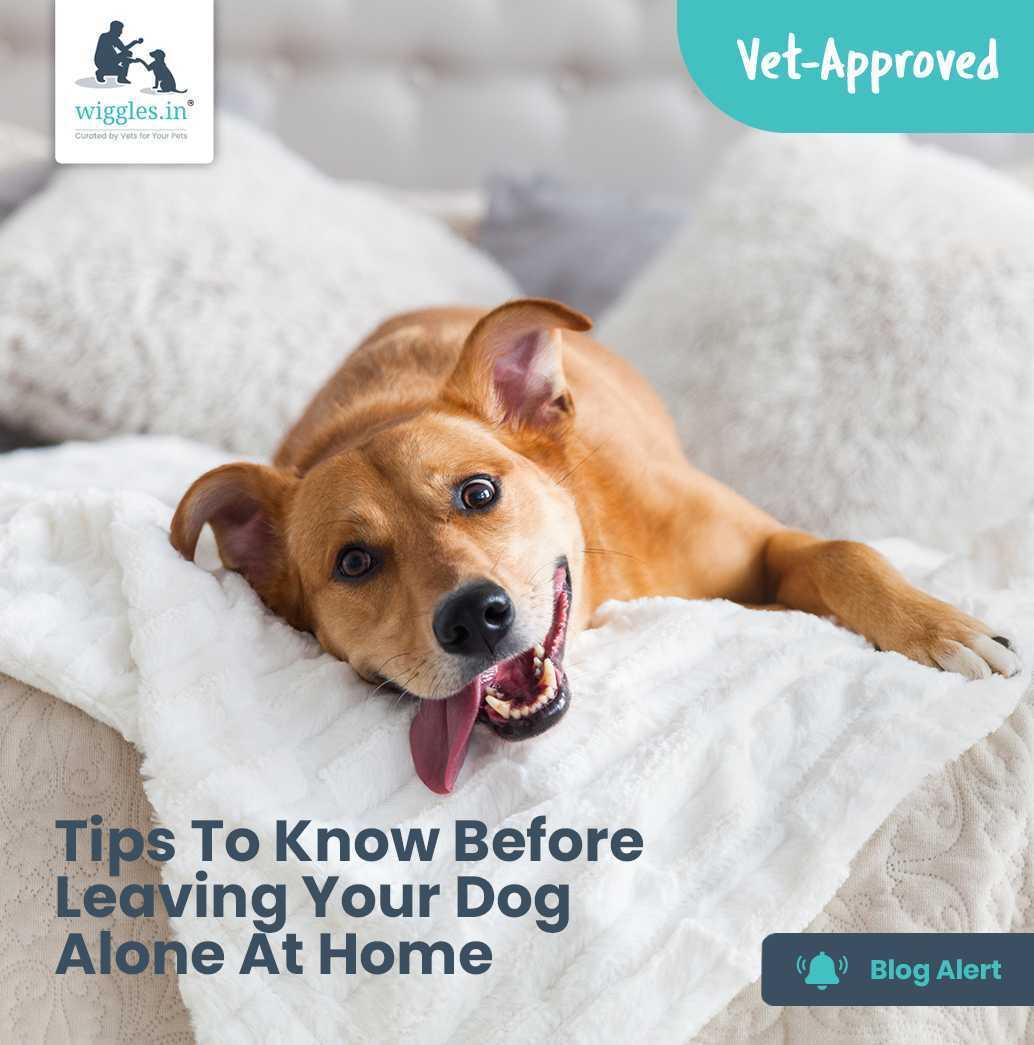Leaving your furbaby at home and not feeling guilty about it is tough. After all, how can you leave your pet all by themselves? Sometimes, even though you might not want to, you’ve got to leave your pets home alone for a few hours. When you’re away, you can either let them roam freely in the house or crate-train them. Some people call crate training as cage training and think caging a dog is an unethical thing to do. But it is completely okay if your dog finds comfort and peace in their crate.
In this blog, we will understand if it is okay to leave your pet alone, how long can your dog stay alone at home, how can you train them to stay alone and some tips that can keep them happy while they are alone.
Is it okay to leave your dog alone, if yes then for how long?
Most of the dog breeds that are commonly adopted by families have evolved to be independent. You as a pet parent need to have more trust and faith in your fur baby. It is important to not make your pet too dependent on you right from the puppy stage. You need to teach them to be independent and confident right from the puppy stage; as this will help to solve most of the problems related to separation anxiety.
It’s okay to leave your dog by themselves for a few hours if they are trained to stay alone. But as a responsible pet parent, you must keep this time frame as minimal as possible because even the most well-trained dogs can become distressed if left alone for a longer period of time.
Based on their age, here are some recommendations:
|
Dog’s Age |
How long can they be left alone |
Reason |
|
Puppies |
2 hours a day (max) |
|
|
Adults (Over 18 months) |
4-8 hours a day (8 hours being the max) |
|
|
Elderly dog (Small-sized dogs- 11 years Medium-sized dogs- 10 years Large-sized dogs- 8 years Extra-large sized dogs- 7 years) |
2-6 hours a day (6 hours being the max) |
|
What happens when you leave your dog alone?
While some dogs may adjust well to staying alone, some dogs might have a tough time dealing with your absence. Some dogs may develop behavioral issues like separation anxiety that can stem from boredom, anxiety and stress by being alone at home.
Following symptoms can be seen in dogs who may have developed behavioral issues due to your absence.
-
Biting
-
Chewing on furniture & clothes
-
Eating excessive amounts of food
-
Barking, howling or whimpering
-
Urination
-
Scratching
-
Running away from home
-
Other unusual and distressing behaviors
If you notice any of the above behaviors in your dog, you should consult a dog trainer or a canine behaviorist to correct this behavior and help your dog feel better.
Every dog adjusts differently to being alone at home
Factors to consider when leaving your dog home alone
As a general rule of thumb, most adult dogs can be left alone for up to 8 hours a day but there are many factors that come into play when deciding how long you can leave your dog alone.
Training
A well-trained dog is more comfortable when left alone because they know you will come back soon and can cope with you not being around for a few hours. However, if your dog is not trained you should consider training them before leaving them alone at home.
Your pet’s past
If your furbaby has past trauma, separation anxiety or any other anxiety-related issues, they may not adjust well to staying away from you for long hours.
Breed
Some breeds of dogs are naturally more anxious than others. For example - some guard dogs may not need potty breaks for up to 10 hours but some breeds have smaller bladders and may have to attend nature’s call at that very minute. Some breeds of dogs can be left alone for hours but some may get anxious within a few hours of you leaving the house.
With 5+ years of experience, Kushal Chipkar, Manager of Dog Training at Wiggles.in says “Toy breeds are more prone to separation anxiety since pet parents have the habit to carry them around all the time. It’s a bit tricky to train these medium and small breeds for separation anxiety. Working dog breeds on the other hand mostly spend time resting during the day if they have had a good morning walk and exercise, hence it is easy to train them to stay alone for long periods of time.”
In general, any dog can be trained to live alone, it’s just that you need to start the training right from the puppy stage. If you’re wondering how to train your adult dog to stay alone, keep reading!
Temperament and personality
Sometimes, even though your pet checks other boxes for being well-adjusted to staying alone, they may not have the personality or temperament to do so. Speaking to a canine behaviorist can help you understand your dog’s personality and whether it would be okay to leave them home alone.
Age
As mentioned above, puppies and senior dogs may need more bathroom breaks than adult dogs. Senior dogs may also experience other age-related medical issues that may require you to monitor them and provide medication at regular intervals. In the case of puppies, their curious and playful nature and little control over their bladder may require your constant supervision and care.
Bathroom routine
Every dog has a different bathroom routine, some may need their bathroom break after 8 hours of their previous one and some need it after 4 hours. Knowing our dog’s needs and schedule can help you determine how long they could be left alone.
How to train your dog to be alone for a few hours?
Training is of the utmost importance before you leave your dog at home. Here are some steps to train your dog to be alone for a few hours:
-
Get ready to leave home but don’t leave. Change your clothes, put on your shoes, grab your keys and do everything you would usually do before leaving. But don’t leave the house. When you do these actions and do not leave home, it lets your dog know that these activities are normal and nothing to worry about
-
Give your dog the “stay” command, go to a nearby room and close the door. This way your dog will wait for you to come back as they know you will always give another command after “stay”
-
Wait in this room for a few minutes and come back casually, do not make a big deal out of it. Not making your entrances and exits dramatic will let your dog know that nothing extraordinary is happening and it’s business as usual
-
Slowly, increase the amount of time you stay away from your dog. Day 1 stay in the room for 2 minutes, day 2 for 4 minutes, day 3 for 6 minutes and so on. The reason to gradually increase the time is to not shock your dog all at once but build their trust slowly and steadily
-
Eventually, your dog should be okay in your absence because they know you will come back
-
The most important things to remember are- Never make a big deal on your entrances and exits and make sure your dog is calm before you leave
Are crates advisable to leave your dog alone for 8 hours?
Most adult dogs who are crate-trained can stay in their crates for up to 8 hours. Crating a dog is completely okay when your dog is happy, healthy and used to their crate. Some dogs like the privacy and coziness of their crate and some don’t. It depends on your dog’s personality, temperament, habits and energy level. Puppy cages or puppy crates should only be used when your puppy is crate trained. Puppies should not be left alone in their crates for long periods of time.
The following table should give an idea of how long your dog can stay in their crate depending on their age. (The table is not a definitive guide but gives a rough idea.)
|
Dog’s age |
Maximum time they can spend in the crate |
|
8-10 weeks |
30-60 minutes |
|
11-14 weeks |
1-3 hours |
|
15-16 weeks |
3-4 hours |
|
17+ weeks |
4-5 hours |
|
Healthy adult dogs |
8 hours |
Crate training can help your dog build a positive association with their crate
However, there are some reasons for not crating a dog, some of these reasons are:
-
The crate size is not right for your dog
You have noticed separation anxiety in your dog
Your dog is unwell and has vomiting or diarrhea
-
-
You will be away from your puppy for more than 4-5 hours or 8 hours if you have an adult dog
-
Your dog tries to escape the crate and damages it
-
Your dog eliminates in the crate
-
Your dog barks, howls or gets visually upset while in the crate
-
You haven’t taken your dog for a walk before creating them
-
The temperature in the room or crate is not right (too hot or too cold)
If you're traveling and can't take your pet with you, can you leave them alone?
If you’re taking a short trip and will be back within 8 hours, you can leave your healthy adult dog alone. But if you have a puppy, it might be harder for them to stay without you. But don’t fret, if you absolutely have to leave your dog alone, (even though you don’t want to) there are some other options you can consider to make sure your dog is well looked after even in your absence.
Tips for leaving your dog alone at home
Leaving your dog home alone is probably one of the hardest things for a pet parent to do. But here are a few tips that can make leaving your dog alone at home easier for you and your pet!
Don’t leave them alone, take your dog with you if you can!
Whether you’re traveling or going to work, see if you can take your dog with you. Check your office’s policies regarding bringing a pet to work. Choose road trips or train journeys when you’re traveling. Traveling by flight separates your pet from you as they have to be kept in crates. You can check with your flight personnel if your pet can stay inside the cabin with you. Carry all necessary equipment, vet’s certificates and other necessary documents when traveling with your pet. Check for pet-friendly hotels and restaurants.
Baby proof the house
This is the first and most important thing to do before leaving a puppy or a dog alone at home. Baby proof your medicine drawers or cabinets with food or places your dog could get in while you’re away. Keep toxic food and substances in places your dog cannot reach and lock that with a baby proof latch as well. This will help avoid any accidents and reduce the chances of any kind of damage. Also, make sure you keep all those loose wires away and things that you feel might interest your puppy/dog and they may chew on to it. Even shoes, clothes, tissue boxes, etc. should be kept out of reach.
Tire them out before you leave
Taking your dog on a walk, playing with them or engaging in healthy exercise before you leave can have many benefits. Your dog won’t feel lonely as they’ll get to spend time with you, they’ll feel tired after the walk and might just take a nap after you leave (that means less anxiety) and it’ll also help them fit in one bathroom break.
Hire a dog walker or a dog sitter
Get some help while you’re away. Hire a trusted dog walker to take your dog on a walk or a sitter who can look after your dog. Asking a family member to help out can work too. Let them know about your dog’s habits, bathroom schedule, diet preferences and any other important information. Make sure the person looking after your dog has your dog’s vet’s number and knows where their emergency kit and medicines are kept.
Leave them with toys and clothes with your scent on them
Your dog can get upset if they are bored, so leave them with their favorite toys! Engaging and mind-stimulating toys can keep them busy and active for hours. Just be careful not to leave them with a toy that needs your supervision. Some dogs like to watch TV or listen to music, so you can leave the TV on if you’re going out for a couple of hours.
Leaving them with clothes that smell like you can help provide comfort to your dog and reduce their anxiety.
Choose dog boardings
If you’re traveling for a long time or a few days, then dog boardings should work well for you and your dog. Choose dog boardings that have amenities like a swimming pool, pet gym, park, grooming salon, pet store and fun activities to keep your pet entertained along with 24x7 vets on the premises. Visit the boarding and check the kennels, speak to the caretakers, check if the premises have security cameras and do a thorough checkup before boarding your dog there.
Take a professional’s help
Hiring a professional dog trainer or canine behaviorist can help you train your dog to stay at home calmly. It can provide you with expert insights about your dog’s personality and some foolproof techniques that can train your dog efficiently. If you cannot find time to visit a professional, then get an online behavioral consultation or call a trainer at home at a time that is convenient for you!
Reduce stressors
Some loud sounds or the sound of traffic, bright lights or people outside can be stress-inducing for some pets. While you’re away you can limit these stressors by drawing your curtains and closing the windows. If you know the triggers of anxiety for your pet, try to remove those triggers so that your pet doesn’t get anxious in your absence.
Use Hemp Seed Oil or CannaPaw®
Hemp Seed Oil and CannaPaw® have anxiety-relieving properties. They are holistic oils that reduce your dog’s anxiety without causing any side effects. So if you’re looking for a calmer for your anxious dog, you can try these oils. Massage your dog with these oils or add it in their food, they should work well to keep your dog calm while you’re away.
Wiggles CannaPaw®
Wiggles Hemp Seed Oil
Get a doggie cam
Install a doggie camera in your house. This can help you keep an eye on your dog and take action immediately if something goes wrong. Doggie cameras that come with a speaker are a better option.
Have a designated caretaker
Ask a neighbor or a family member who lives nearby if they can help out in emergency situations while you’re away. Make sure they have the vet’s number, your house keys and know where your dog’s documents and medications are kept. This will help in getting your dog immediate help if you’re not around.
Don’t get nervous around your pet
Your pet can sense what you’re feeling, so stay calm when you’re leaving the house. If you get nervous or panic around them, they’ll sense that something is wrong and will get anxious too. So stay calm with your everyday activities before leaving the house so that your dog can stay calm too when you’re leaving.
It’s never easy to leave your pet at home but we are to help you at every step of your pet parenthood journey. For any queries regarding your pet, our trainers, behaviorists, vets and groomers are only one call away +91 8431620000.
Team Wiggles has started an initiative called #BondedByBlood through which we are trying to create an online repository of ready pet donors. Register your pet today & save a life tomorrow - https://bit.ly/BBBDonorRegistration
Join Wiggles Tribe, our 20k+ community of pet parents on Facebook where our in-house team of vets help to answer your pet-related queries 24/7.
*Disclaimer: This blog is vet-approved and includes original content which is compiled after thorough research and authenticity by our in-house team of vets and content experts. It is always advisable to consult a veterinarian before you try any products, pet food or any kind of treatment/medicines on your pets, as each pet is unique and will respond differently.



















